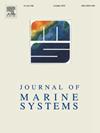利用ECCO产品揭示南海深层垂直速度
IF 2.5
3区 地球科学
Q2 GEOSCIENCES, MULTIDISCIPLINARY
引用次数: 0
摘要
与研究充分的南海水平环流不同,人们对南海的垂直速度,特别是深水的垂直速度知之甚少。垂直流速连接着不同深度的水平环流,在调节垂直物质输送和生化过程中起着至关重要的作用。利用ECCO4产品,研究南海深部垂直速度分布,探讨南海深水更新过程。2500 m以上的垂直速度均呈现出相似的空间特征:下升流起源于吕宋海峡附近并向南海盆地内部扩散,而上升流主要发生在大陆斜坡附近,并在下升流带周围形成上升流环。这种模式随着深度的增加而变得越来越重要,并且暂时稳定。大陆斜坡附近的上升流主要由其底旋分量贡献,表明与局部混合有很强的关系。近底部垂直速度场表现出相似的时空格局。这种垂直速度分布表明吕宋海峡深水溢流是南海深水循环的主要驱动因素。太平洋深水首先下沉到深海盆内部,供给南海深水;然后沿坡面上涌,返回中层,完成南海深水更新。这些发现不仅提高了我们对南海三维环流的认识,而且对公海深水和底水的隆升具有启示作用。本文章由计算机程序翻译,如有差异,请以英文原文为准。
Vertical velocity in the deep layer of South China Sea revealed by using ECCO product
Unlike the well-studied South China Sea (SCS) horizontal circulation, the vertical velocity in the SCS, especially in the deep water, is poorly understood. The vertical velocity connects the horizontal circulations at different depths and plays vital roles in modulating vertical material transport and biochemical processes. Using the ECCO4 product, we investigate the distribution of vertical velocities in the deep SCS, and explore the renewal process of the SCS deep water. The vertical velocities deeper than 2500 m all present similar spatial features: the downwelling originates near the Luzon Strait and spreads to the SCS basin interior, while the upwelling mainly takes place near the continental slope and forms an upwelling ring around the downwelling zone. This pattern becomes more and more significant with depth and is temporally stable. The upwelling near the continental slope is dominantly contributed by its diapycnal component, indicating a strong relation to local mixing. The near-bottom vertical velocity field shows a similar spatial-temporal pattern. This vertical velocity distribution suggests the deep-water overflow from the Luzon Strait is the main driving factor of the SCS deep water recycling. The Pacific deep water first sinks into the deep basin interior to supply the SCS deep water; then, it upwells along the slope and returns to the middle layer to accomplish the SCS deep water renewal. These findings not only improve our understanding of the three-dimensional circulation in the SCS, but also serve as an enlightenment for the uplifting of the deep and bottom waters in the open ocean.
求助全文
通过发布文献求助,成功后即可免费获取论文全文。
去求助
来源期刊

Journal of Marine Systems
地学-地球科学综合
CiteScore
6.20
自引率
3.60%
发文量
81
审稿时长
6 months
期刊介绍:
The Journal of Marine Systems provides a medium for interdisciplinary exchange between physical, chemical and biological oceanographers and marine geologists. The journal welcomes original research papers and review articles. Preference will be given to interdisciplinary approaches to marine systems.
 求助内容:
求助内容: 应助结果提醒方式:
应助结果提醒方式:


